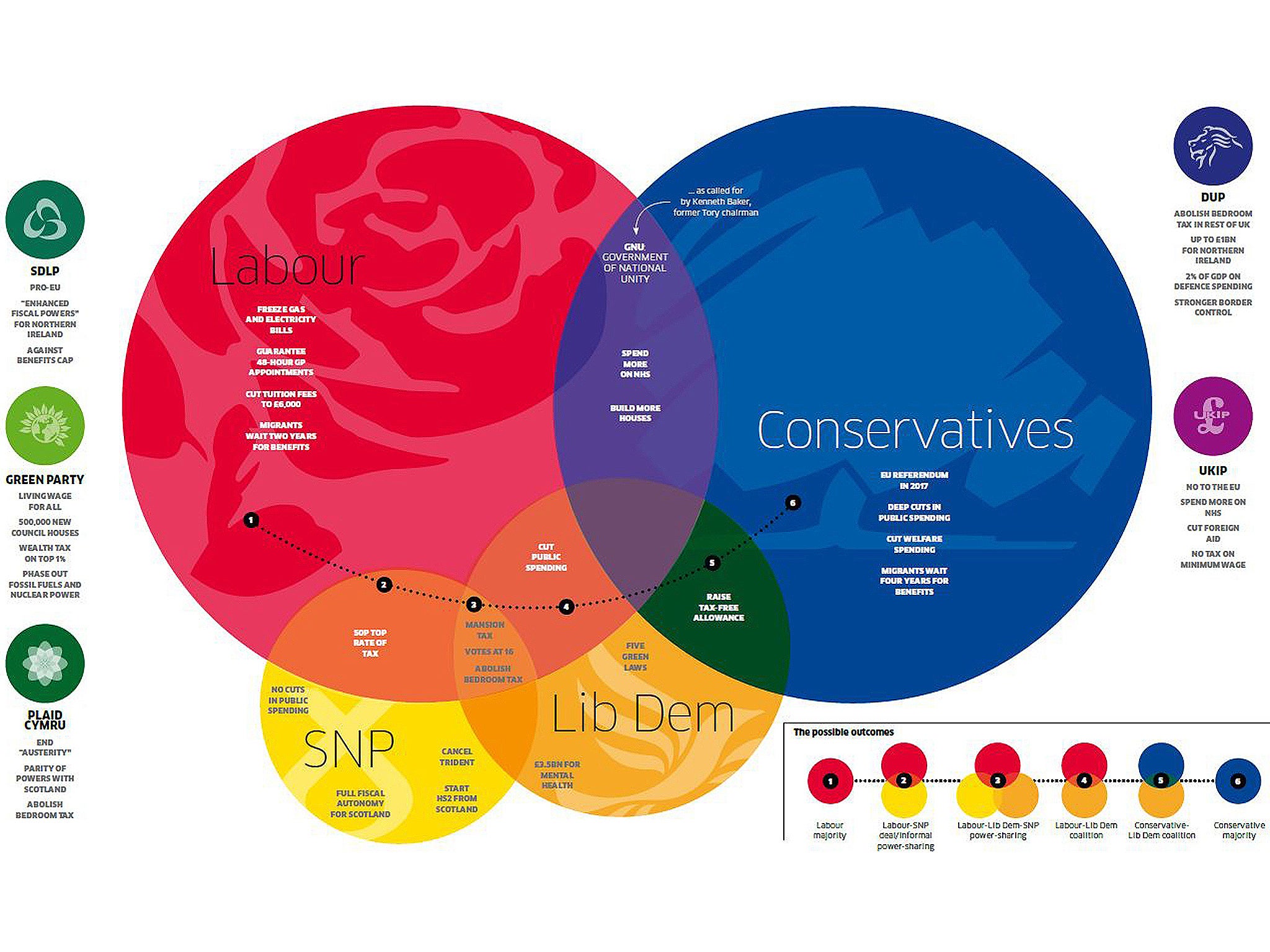General Election 2015: Rainbow coalition, here we come, as the parties cosy up
Confused about all the possible outcomes? John Rentoul offers a guide to how the parties might line up in a new government

Your support helps us to tell the story
From reproductive rights to climate change to Big Tech, The Independent is on the ground when the story is developing. Whether it's investigating the financials of Elon Musk's pro-Trump PAC or producing our latest documentary, 'The A Word', which shines a light on the American women fighting for reproductive rights, we know how important it is to parse out the facts from the messaging.
At such a critical moment in US history, we need reporters on the ground. Your donation allows us to keep sending journalists to speak to both sides of the story.
The Independent is trusted by Americans across the entire political spectrum. And unlike many other quality news outlets, we choose not to lock Americans out of our reporting and analysis with paywalls. We believe quality journalism should be available to everyone, paid for by those who can afford it.
Your support makes all the difference.Here is our super-Venn diagram showing all the likely combinations of parties that might form a government after the election. The line of outcomes stretches from a Labour majority on the left to a Conservative majority on the right, with a range of possible combinations of parties in between. With the opinion polls pointing to a hung parliament, in which no party has a majority, these seem to be the most likely outcomes.
The four big circles show the parties that are expected to have more than 20 seats in the new House of Commons, but the Scottish National Party does not overlap with the Tories because Nicola Sturgeon, its leader, says: “The SNP will not formally or informally prop up a Conservative government.”
In each circle, we summarise the parties’ important policies, and we have tried to identify those on which each party shares common ground with other parties in the overlapping zones. These policies could form the basis of agreements between parties, whether a coalition, pact or support for a minority government “vote by vote”, which is how the SNP has suggested it would back a Labour government.
Around the outside we show the five smaller parties likely to have more than one MP or with significant national support. The Democratic Unionist Party in Northern Ireland might have nine MPs, Ukip four or five, the Social Democratic and Labour Party, Labour’s sister party in Northern Ireland, might have three, Plaid Cymru, the Welsh nationalists, might have three and the Green Party one. (Sinn Fein, the other main Northern Ireland party, refuses to take its seats in the Commons.) If there is a hung parliament in which no combination of two or three big parties has a majority, these smaller parties may come into play. Peter Robinson, DUP leader, said last month: “We are one of those parties that has not determined that we will only speak to one party.”
Nigel Farage, the Ukip leader, also said last month: “I would look to do a deal where we would back key votes for them [the Tories] – such as the Budget – but in return for very specific criteria on an EU referendum... I want a full and fair referendum to be held in 2015.”
Alasdair McDonnell, SDLP leader, said: “We will be the left-of-centre backbone of a Labour administration.” Like the SNP, McDonnell said, “the SDLP will categorically refuse to support David Cameron and the Conservative Party”. Plaid Cymru and the Greens have also said that they would not support a Conservative government.
All the parties are committed to spending more on the NHS. Labour would allocate the revenue from the mansion tax to it. The Lib Dems wants to spend up to £8bn a year more after five years. The Conservatives matched that recently, but without saying where the money would come from. Ukip wants an immediate £3bn a year. Health is devolved to Scotland, Wales and Northern Ireland.
The Independent has got together with May2015.com to produce a poll of polls that produces the most up-to-date data in as close to real time as possible.
Click the buttons below to explore how the main parties' fortunes have changed:
All data, polls and graphics are courtesy of May2015.com. Click through for daily analysis, in-depth features and all the data you need. (All historical data used is provided by UK Polling Report)
Join our commenting forum
Join thought-provoking conversations, follow other Independent readers and see their replies
Comments